|
SANDRO BOTTICELLI - TRIAL OF MOSES

Sandro Botticelli, Public domain, via Wikimedia Commons
1481-1482 |
- The Trial of Moses is also called the Youth
of Moses and was completed by Sandro Botticelli in 1482.
- It is located in the Sistine Chapel (Cappella Sistina, Vatican).
|
Botticelli integrated seven episodes from the life of the young Moses into the landscape with considerable skill, by opening up the surface of the picture with four diagonal rows of figures.
(wga.hu)
|
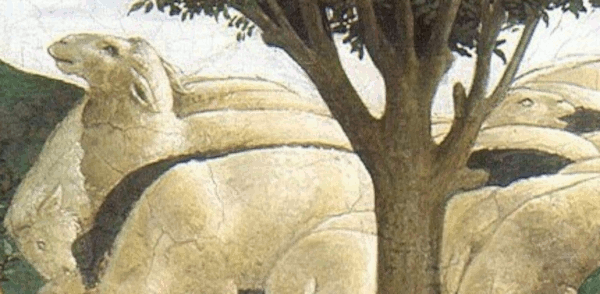
Sheep |
- This was a parallel between the
stories of Moses and those of Christ, as a sign of continuity between the Old and the New Testament.
- The fresco shows a number of events that preluded
Moses' journey from Egypt and captures the dramatic moment
of his divine calling.
|
Botticelli, helped by numerous assistants, painted three scenes. On 17 February 1482 his contract was renovated, including the other scenes to complete the chapel's decoration. However, on 20 February his father died: he returned to Florence, where he remained.
(Wikipedia)
|
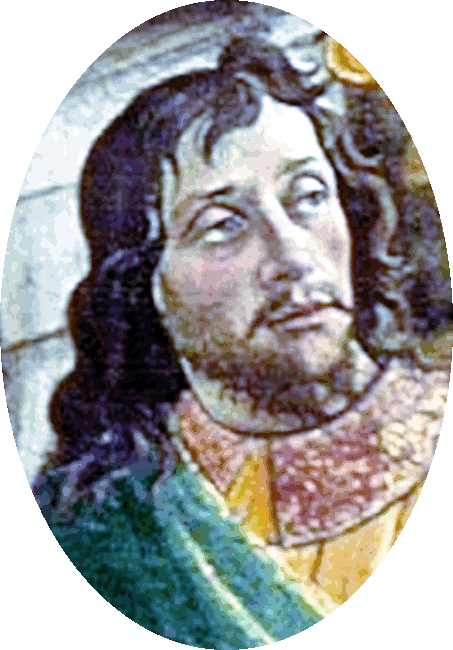
Moses |
- A youthful Moses is depicted 7 times in the painting and is shown
wearing a gold robe and green cloak.
- The fresco which is
on the south wall, shows several episodes of Moses' youth, taken from Exodus.
-
The scenes illustrate the phases of Moses’ early life and how he became ready to become the leader of the Israelites.
|
On 27 October 1480, Botticelli, together with other Florentine painters, left for Rome where he had been called as part of the reconciliation project between Lorenzo de' Medici, the de facto ruler of Florence, and Pope Sixtus IV.
(Wikipedia)
|
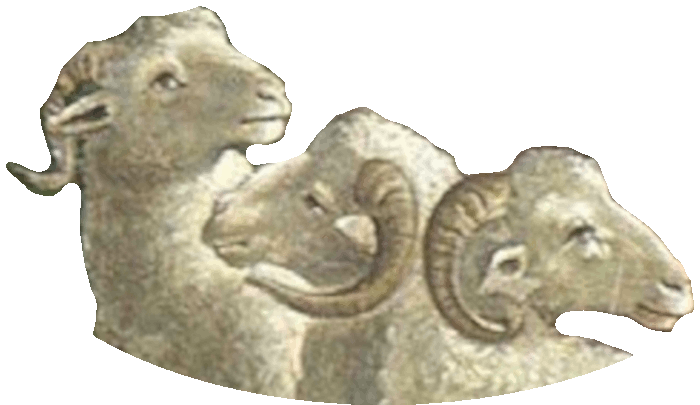
Ram |
- It parallels the fresco on the opposite wall in the
Sistine Chapel, also by Botticelli, which depicts the
The Temptations of Christ.
- The two paintings
are typologically related in that both of them deal with the
theme of temptation.
|
As the Moses cycle starts on the wall behind the altar, the scenes should, unlike the pictures of the temptations of Christ, be read from right to left. (wga.hu)
|
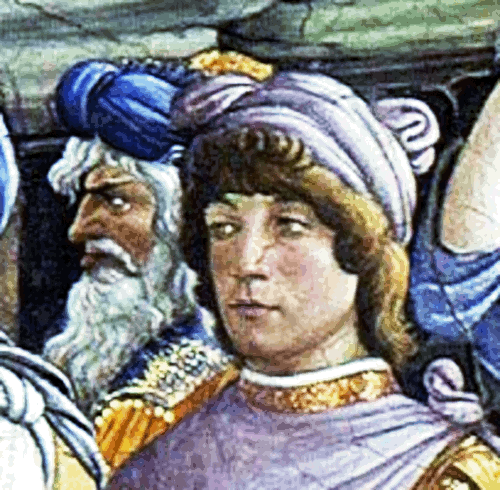
Moses' people |
- The story begins after Moses had grown up and he had
travels
to see his people at their hard labor.
|
Now Moses was tending the flock of Jethro his
father-in-law, the priest of Midian, and he led the
flock to the far side of the wilderness and came to
Horeb, the mountain of God. (Exodus 3:1)
|
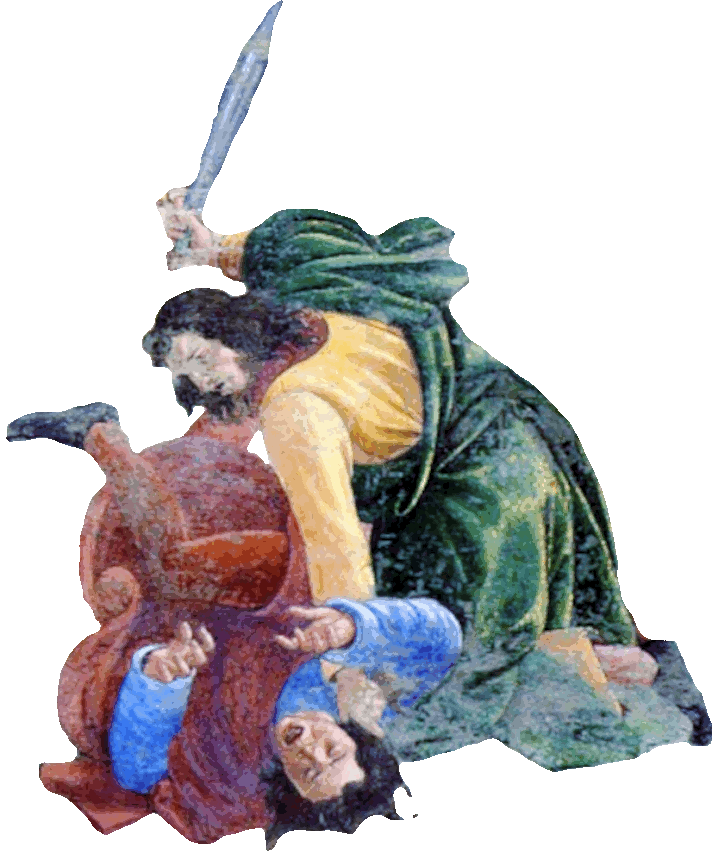
Moses kills an Egyptian |
- On the bottom right Moses
is striking an Egyptian with his sword who had harassed and
beat a
young Israelite.
- Botticelli called the Egyptian an
'overseer' and that means spy and some call trouble-shooter
- They befriend you, invite you over for dinner, watch
everything you do, in an attempt to get you to reveal
wrongdoings so they can turn you into the authorties.
- Usually they go after those they don't like because
they're revealing too much truth.

Young Israelite cared for |
- Moses kills the Egyptian and hides his body in the sand.
- To the right of this scene, you can see that a woman in blue comforts the
wounded and traumatized young Israelite while leading him away.
|
Looking this way and that and seeing no one, he killed the Egyptian and hid him in the sand.
(Exodus 2:12)
|
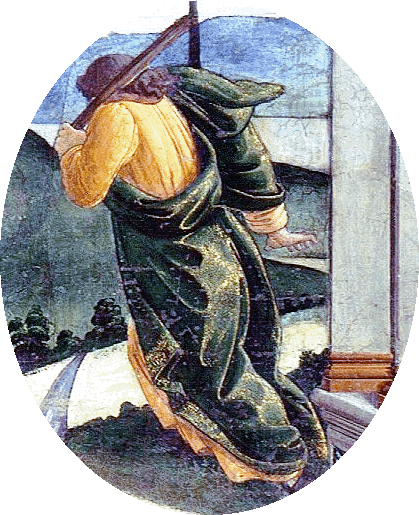
Moses flees |
- Moses flees into the desert
which is a parallel to the episode of Jesus defeating the Devil.
- He acts in what he perceives as righteous defense of his
fellow Hebrew, but his actions lead to fear and ultimately,
his flight from Egypt.
-
After Moses in a shining yellow garment, angrily strikes an Egyptian overseer,
he flees Egypt because the Pharaoh wanted to kill him and he returns to the Midianites.
|
When Pharaoh heard of this, he tried to kill Moses, but Moses fled from Pharaoh and went to live in Midian, where he sat down by a well.
(Exodus 2:15)
|
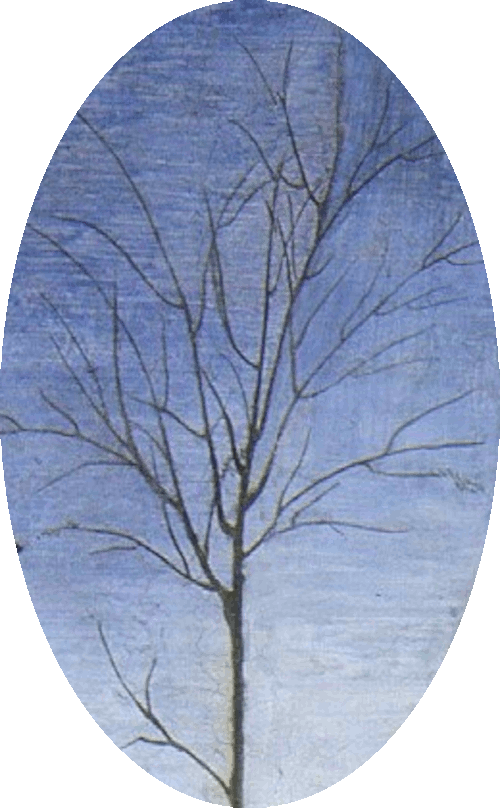
Tree of Knowledge |
- In the scene where Moses flees from Egypt to Midian, you can see a tall tree without any leaves in front of him.
- This tree signifies the Tree of Knowledge to indicate that Moses will transform himself into a better person when he moves to Midian.
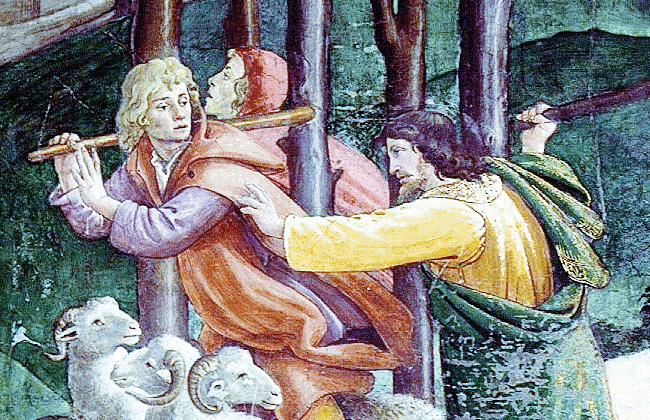
Moses fights the shepherds |
- In the next scene Moses encounters seven daughters of a
priest of Midian who are drawing water for their flock when
shepherds try to drive them away.
- Moses fights the shepherds,
dressed in red and orange, who were
preventing Jethro's (Reuel's) daughters from drawing water from the well for their
sheep at the pit.
|
Now a priest of Midian had seven daughters, and they came to draw water and fill the troughs to water their father’s flock.
(Exodus 2:16)
|
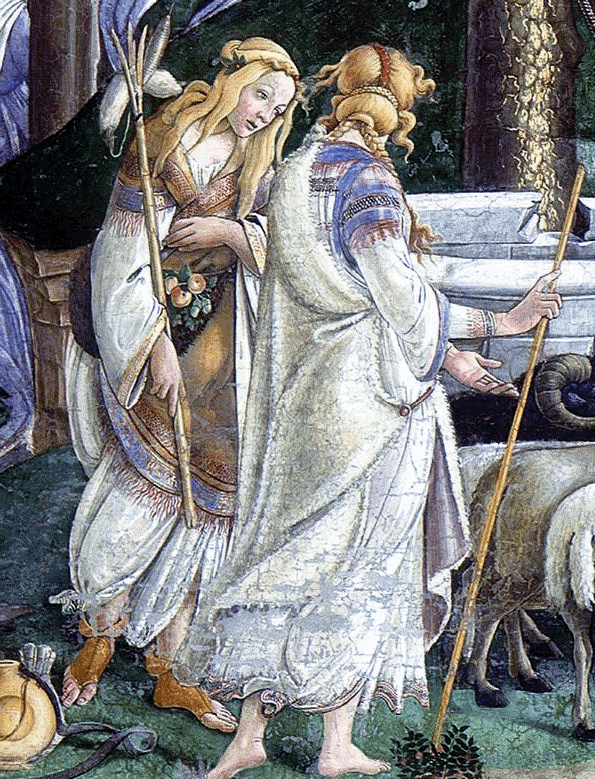
Jethro's daughters |
- One of Jethro's daughters,
Zipporah, on the left, who was Moses' future wife, was caring for the
sheep with her sister.
- Moses intervenes and helps them
water their sheep.
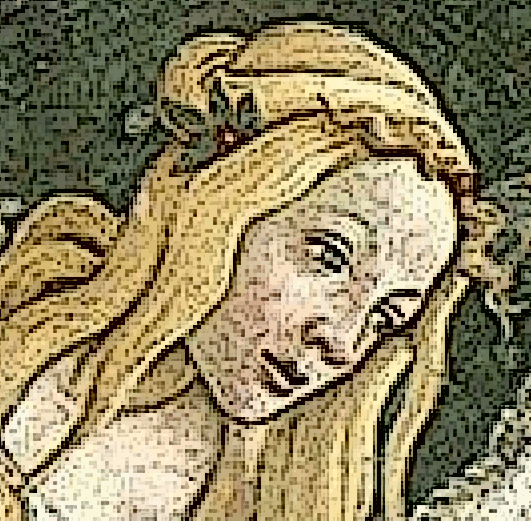
Zipporah |
- Zipporah has a myrtle leaf in her hair which symbolizes the conversion of a non-Jewish person to Christian faith.
- She also holds a spindle in her right hand (a device to spin wool into a thread), which is a reminder of the Virgin Mary.
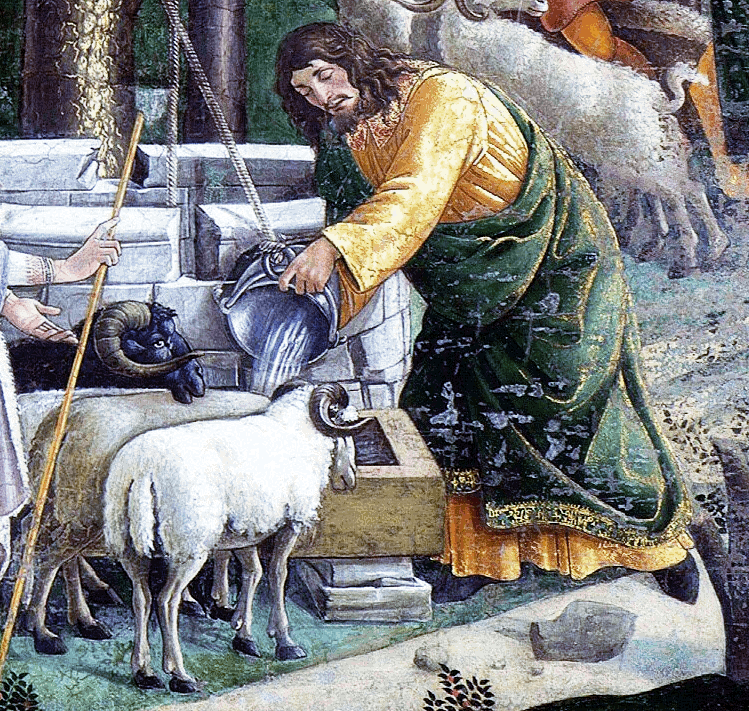
Moses at the watering hole |
- Moses then fills the bucket and takes the water to the
livestock.
- He drew the water from the well and pours it into a trough.
- The water that Moses pours into the trough is a symbol of
Baptism and the sheep symbolize the Church.
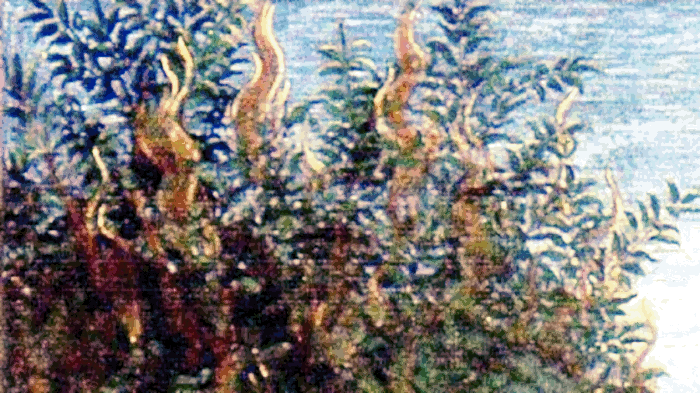
Burning bush |
- Moses then saw a bush burning in a strange supernatural
way and an angel appeared.
|
There the angel of the Lord appeared to him in flames of fire from within a bush. Moses saw that though the bush was on fire it did not burn up. So Moses thought, “I will go over and see this strange sight—why the bush does not burn up.”
(Exodus 3:2-3)
|
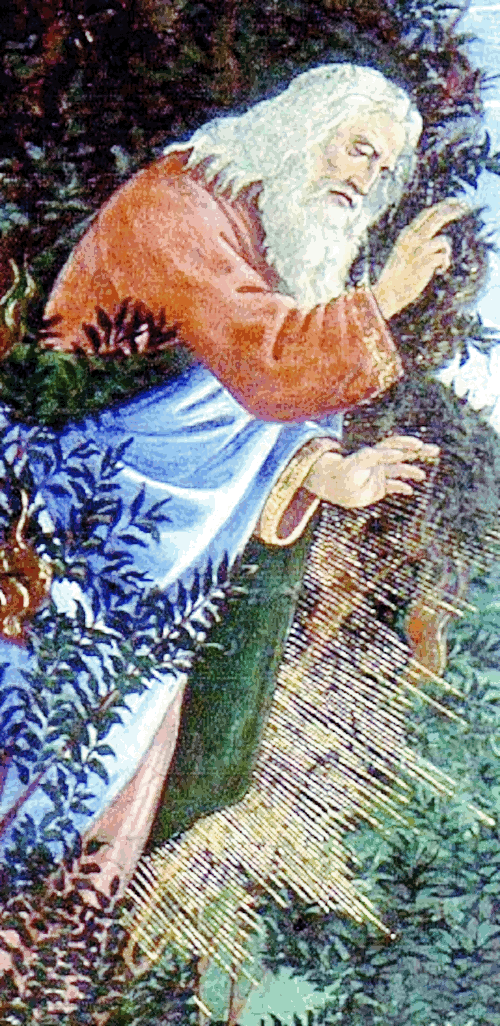
God |
- God was standing in the burning bush and saw that Moses
was looking at it.
|
When the Lord saw that he had gone over to look, God called to him from within the bush, “Moses! Moses!” And Moses said, “Here I am.” (Exodus 3:4)
|
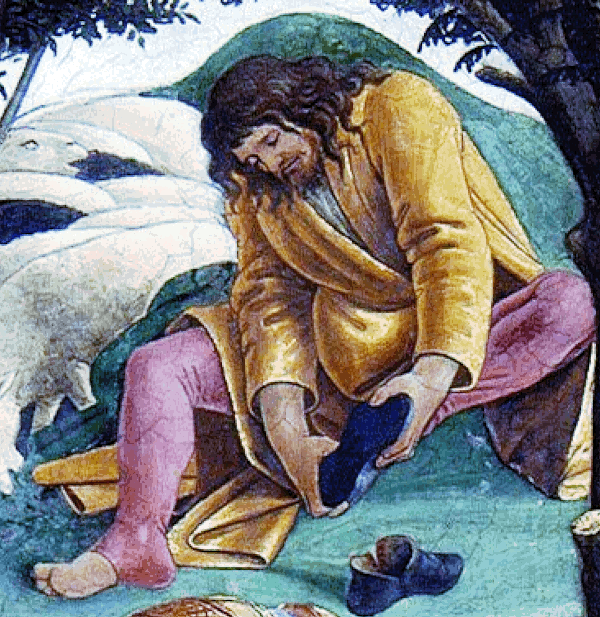
Moses removing his shoes |
- In the upper left corner, God commands Moses to remove his sandals because the ground he is standing on is holy.
- This act of removing sandals symbolizes reverence and respect for the sacred presence of God.
- It is a recognition that Moses is in the presence of the divine and that the ground itself is imbued with holiness due to God's presence.
|
“Do not come any closer,” God said. “Take off your
sandals, for the place where you are standing is holy
ground.” (Exodus 3:5)
|
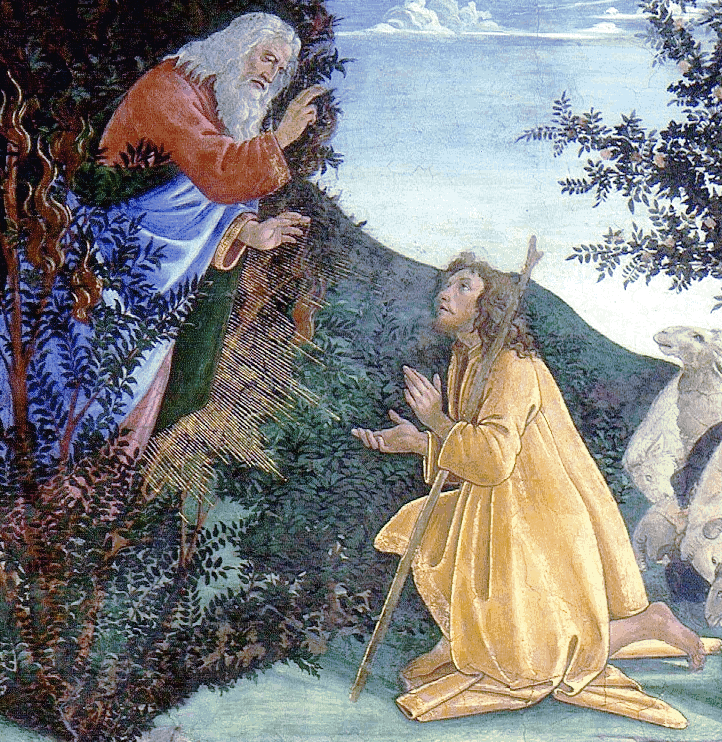
Moses blessed by God |
-
In the scene in the top left, Moses then receives from God the task to return to Egypt and free his people.
- Moses suddenly appears with a golden rod in his hand
which he received from God to lead the Israelites.
|
Then he said, “I am the God of your father, the God of Abraham, the God of Isaac and the God of Jacob.” At this, Moses hid his face, because he was afraid to look at God. (Exodus 3:6)
|
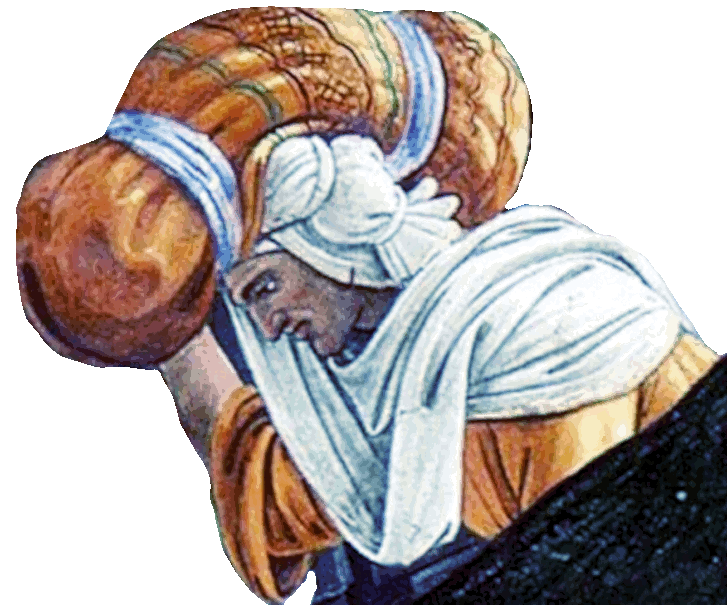
Misery of the Israelites
Bound to the phallic |
-
There are types of people that need a leader and were
waiting for Moses to take them out of the desert.
|
The Lord said, “I have indeed seen the misery of my people in Egypt. I have heard them crying out because of their slave drivers, and I am concerned about their suffering. So I have come down to rescue them from the hand of the Egyptians and to bring them up out of that land into a good and spacious land, a land flowing with milk and honey—the home of the Canaanites, Hittites, Amorites, Perizzites, Hivites and Jebusites. (Exodus 3:7-8)
|
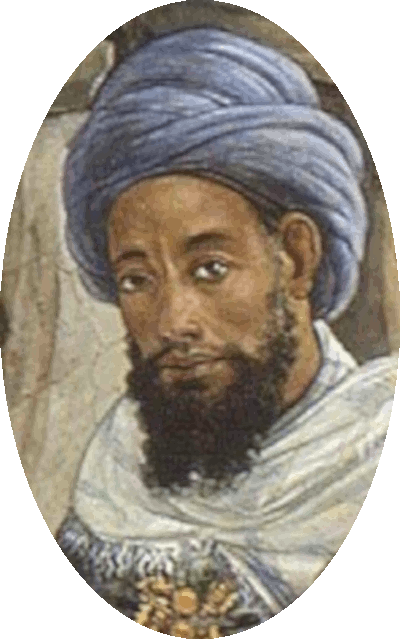
Pharaoh of Egypt |
- God wanted Moses to visit the Pharaoh in Egypt to talk to
him about the oppression against the Israelites.
|
And now the cry of the Israelites has reached me, and I have seen the way the Egyptians are oppressing them. So now, go. I am sending you to Pharaoh to bring my people the Israelites out of Egypt.”
But Moses said to God, “Who am I that I should go to Pharaoh and bring the Israelites out of Egypt?” (Exodus 3:9-11)
|
|

